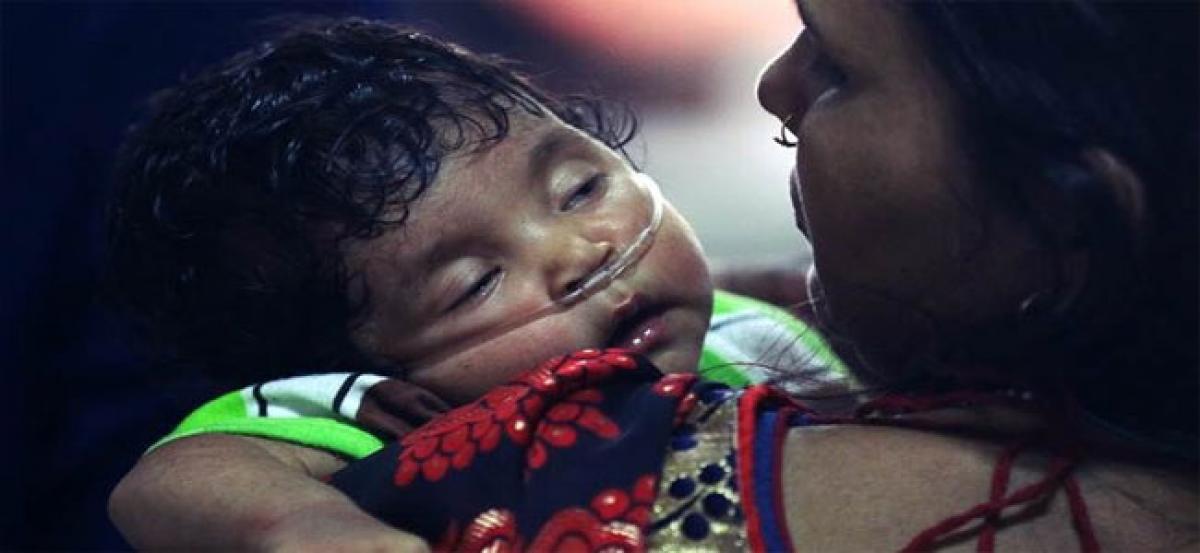Live
- 2024 on track to be hottest year on record
- PM Modi’s visit to Solapur: Women applaud ‘Double-Engine’ government’s initiatives
- Nagarkurnool MLA Dr. Kuchukulla Rajesh Reddy Campaigning in Maharashtra Elections
- Wife Kills Husband with Her Lover: Details of Veldanda Murder Case Revealed by SP Gaikwad
- Strict Action on Violations of Food Rights: Telangana Food Commission Chairman Goli Srinivas Reddy
- Smooth Conduct of Group-3 Exams with Strict Security Measures: Collector Badavath Santosh
- Delhi HC orders cancellation of LOC issued against Ashneer Grover, wife
- Shami’s absence a major blow for India in BGT, says Paul Adams
- Will organize protests at borders if attack on minority Hindus in Bangladesh not stopped: Bengal LoP
- Dutch Ambassador Marisa Gerard Meets Telangana CM A. Revanth Reddy in Delhi
Just In

The child mortality rates in the country have fallen by 62% from 125 per 1,000 births in 1990 to 47 per 1,000 births in 2015, slightly short of the Millennium Development Goal of a 66% reduction.
The child mortality rates in the country have fallen by 62% from 125 per 1,000 births in 1990 to 47 per 1,000 births in 2015, slightly short of the Millennium Development Goal of a 66% reduction.
However, in the last 15 years, deaths among infants in India due to low birth weight have increased. The increase in low birth weight deaths has been noticed in poorer states and rural areas of Madhya Pradesh, Uttar Pradesh, Rajasthan, Bihar, Punjab, and Haryana.
A Lancet study points out that premature birth and low birth weight deaths are strongly linked to maternal and prenatal factors such as antenatal care, education, and anaemia
These findings were part of the Million Death Study (MDS), conducted from 2001 to 2015 in 1.3 million homes in India by the Registrar General of India. The survey whose findings were published in The Lancet on September 19 pointed out that progress in the reduction of the current global total of 6 million child (younger than 5 years) deaths depends greatly on India, which accounts for about a fifth of the global total.
The study has also pointed out that premature birth and low birth weight deaths are strongly linked to maternal and prenatal factors such as antenatal care, education, and anaemia.
These findings also corroborated by the National family health survey -4. In Haryana, the incidence of anaemia (Hb less than 11 gram) among all women aged 15 to 49, has increased from 56.1% in 2005-06 to 62.7 % in 2015-2016. The percentage of pregnant women with anaemia in Punjab has gone up from 41.6% in 2005-06 to 42% in 2015-16.
Prematurity or low birth weight mortality rates rose in rural areas (from 13·2 per 1000 live births in 2000 to 17·0 per 1000 live births in 2015) and in poorer states (from 11·3 per 1000 live births in 2000 to 17·8 per 1000 live births in 2015), while in richer states and urban areas it declined, resulting in an average increase in deaths from 12 per 1000 live births in 2000 to 14 per 1000 live births in 2015.
The absolute number of neonatal deaths from prematurity or low birth weight rose from 3, 42,000 deaths in 2000 to about 3,70,000 by 2015. The study finds out that about 2.9 crore children have died in India between 2000 and 2015. Largest number of children, close to 10 lakh died in rural areas, while 8.5 lakh children died in nine poorer states. Neonatal deaths were 50% of all child deaths in 2000, but this proportion rose to 58% by 2015.
With declines in other causes in neonates, prematurity or low birth weights are a rising proportion of a shrinking total. Nearly 60% of deaths among children younger than 5 years in India in 2015 were among neonates, which is in the first month of life.
The other findings of the study found that most deaths in India occur at home and without medical attention.
Interestingly, deaths from injuries rose from the sixth rank to third rank. As many as 1,700 of the 69,000 injury deaths in 2015 were due to falls and about 1,400 (20%) were due to drowning, underlining the need to monitor children more carefully.
Around 60 lakh children, younger than five years of age die globally every year and India carries one fifth of the burden – which is 12 lakh Indian children die before reaching the fifth birthday.
The critical challenge before India is to meet the 2030 Sustainable Development Goals for child mortality. It will need to maintain the current trajectory of 1–59-month mortality and accelerate declines in neonatal mortality (to >5% annually) from 2015 onwards. Continued progress in reduction of child mortality due to pneumonia, diarrhoea, malaria, and measles at 1–59 months is feasible. Additional attention to low birth weight is required, notes The Lancet.
Listing the causes of child mortality, MDS found that the diseases prioritised under the National Health Mission had the greatest declines: pneumonia and diarrohea mortality fell by over 60%, mortality from birth-related breathing and trauma during delivery fell by 66%, and measles and tetanus mortality fell by 90%.
These declines were greater in girls, so that now India has, remarkably, equal numbers of girls and boys dying, which is a big improvement from just a few years ago.
Punjab is leading the northern states in bringing down deaths in children under the age of five. In 2015, the state recorded 14,080 deaths in this bracket as compared to Haryana, which witnessed 22,877 deaths. Uttar Pradesh ranked the lowest with 316,198 deaths.
By Gudipati Rajendera Kumar

© 2024 Hyderabad Media House Limited/The Hans India. All rights reserved. Powered by hocalwire.com







